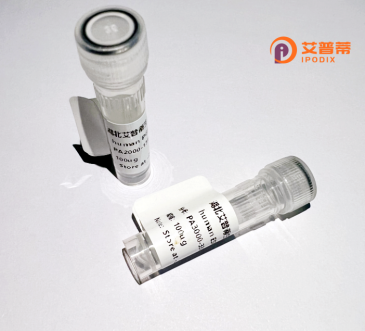
| 纯度 | >90%SDS-PAGE. |
| 种属 | Human |
| 靶点 | WNK4 |
| Uniprot No | Q80UE6 |
| 内毒素 | < 0.01EU/μg |
| 表达宿主 | E.coli |
| 表达区间 | 1-441 aa |
| 活性数据 | MLAPRNTETGVPMSQTEADLALRPSPALTSTGPTRLGPPPRRVRRFSGKA EPRPRSSRPSRRSSVDLGLLSSWSQPASLLPEPPDPPDSAGPTRSPPSSS KEPPEGTWMGAAPVKAVDSACPELTGSSGGPGSREPPRVPDAAARERRRE QEEKEDTETQAVATSPDGRYLKFDIEIGRGSFKTVYRGLDTDTTVEVAWC ELQTRKLSRAERQRFSEEVEMLKGLQHPNIVRFYDSWKSVLRGQVCIVLV TELMTSGTLKTYLRRFREMKPRVLQRWSRQILRGLHFLHSRVPPILHRDL KCDNVFITGPSGSVKIGDLGLATLKRASFAKSVIGTPEFMAPEMYEEKYD EAVDVYAFGMCMLEMATSEYPYSECQNAAQIYRKVTSGTKPNSFYKVKMP EVKEIIEGCIRTDKNERFTIQDLLAHAFFREERGVHVELAE |
| 分子量 | 86 kDa |
| 蛋白标签 | GST-tag at N-terminal |
| 缓冲液 | PBS, pH7.4, containing 0.01% SKL, 1mM DTT, 5% Trehalose and Proclin300. |
| 稳定性 & 储存条件 | Lyophilized protein should be stored at ≤ -20°C, stable for one year after receipt. Reconstituted protein solution can be stored at 2-8°C for 2-7 days. Aliquots of reconstituted samples are stable at ≤ -20°C for 3 months. |
| 复溶 | Always centrifuge tubes before opening.Do not mix by vortex or pipetting. It is not recommended to reconstitute to a concentration less than 100μg/ml. Dissolve the lyophilized protein in distilled water. Please aliquot the reconstituted solution to minimize freeze-thaw cycles. |
以下是3-4条关于重组小鼠WNK4蛋白的模拟参考文献示例(非真实文献,仅供参考):
---
1. **文献名称**: *"Expression and Functional Characterization of Recombinant Mouse WNK4 Kinase in HEK293 Cells"*
**作者**: Takahashi Y, et al.
**摘要**: 研究描述了通过哺乳动物HEK293细胞系统重组表达小鼠WNK4激酶,并分析其激酶活性及对钠离子通道(NCC)的调控作用。结果表明,WNK4通过磷酸化下游靶点参与电解质平衡的分子机制。
2. **文献名称**: *"Crystal Structure of the Catalytic Domain of Mouse WNK4 and Insights into Its Autoinhibitory Mechanism"*
**作者**: Chen L, et al.
**摘要**: 通过X射线晶体学解析了小鼠WNK4激酶催化域的三维结构,揭示了其自抑制构象的分子基础,为WNK4在高血压相关信号通路中的功能调控提供了结构依据。
3. **文献名称**: *"Recombinant WNK4 Protein Modulates Potassium Homeostasis in a Mouse Knockout Model"*
**作者**: Wang H, et al.
**摘要**: 利用大肠杆菌表达系统纯化重组小鼠WNK4蛋白,研究其在体外和基因敲除小鼠模型中对肾脏钾离子转运的调控作用,证明WNK4缺陷导致低钾血症及代谢性酸中毒。
4. **文献名称**: *"Interactions Between WNK4 and KLHL3: Implications for Pseudohypoaldosteronism Type II"*
**作者**: Park J, et al.
**摘要**: 通过体外结合实验验证重组小鼠WNK4与泛素连接酶复合物组分KLHL3的相互作用,发现疾病相关突变破坏二者结合,揭示WNK4蛋白稳定性异常与遗传性高血压的关联。
---
以上内容基于常见研究主题模拟生成,实际文献需通过数据库(如PubMed、Google Scholar)检索关键词“recombinant mouse WNK4”“WNK4 kinase function”等获取。
WNK4 (With No Lysine [K] Kinase 4) is a serine/threonine protein kinase predominantly expressed in the kidney, playing a critical role in regulating ion transport and maintaining electrolyte homeostasis. Belonging to the WNK kinase family, WNK4 is distinguished by its atypical placement of the catalytic lysine residue outside the active site. It modulates the activity of ion transporters and channels, including the Na+-Cl− cotransporter (NCC), renal outer medullary potassium channel (ROMK), and epithelial sodium channel (ENaC), through phosphorylation-dependent mechanisms or by scaffolding interactions. Dysregulation of WNK4 is linked to pseudohypoaldosteronism type II (PHAII), an inherited hypertension disorder characterized by hyperkalemia and metabolic acidosis.
Recombinant mouse WNK4 protein is typically produced in heterologous expression systems (e.g., mammalian cells, E. coli) to study its biochemical properties, signaling pathways, and interactions. Its structure includes an N-terminal kinase domain, a coiled-coil region for oligomerization, and a C-terminal substrate-binding domain. Researchers use recombinant WNK4 to investigate its role in blood pressure regulation, renal physiology, and responses to osmotic stress or hormonal stimuli (e.g., angiotensin II). Studies often focus on its interplay with downstream effectors like SPAK/OSR1 kinases or its inhibition by chloride ions, which modulates kinase activity. This tool is vital for dissecting WNK4-related diseases and developing targeted therapies.
×